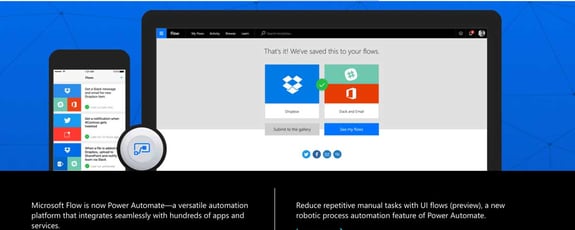At the Ignite 2019 Conference, Microsoft unveiled the latest additions and features to its Power Platform family and rebranded its workflow/automation engine, Flow, as Power Automate to bring it in line with the rest of the platforms.
The Power Platform is the collection of Power BI, PowerApps, and Flow (now Power Automate), which serves as a business tool that allows companies to analyze, act and automate across their entire organization. The announcement included a significant update to Power BI’s security, better integration with Microsoft Teams, and the launch of Power Virtual Agents.
Along with the rebrand to Flow, Microsoft has announced some significant features to the engine that will make it even more effective for businesses. The Power Automate app will now support robotic process automation (RPA), which means UI flows are now supported as well, and the app can be used for end-to-end automation.
What is Power Automate?
Power Automate is designed to automate workflows, allowing users to automate processes across applications and streamline business workflows. It is very similar to an If This Then That (IFTTT) platform and makes a huge difference to repetitive tasks and company productivity.
What do the changes mean?
RPA automates business processes, using AI and bots to carry out everyday, repetitive tasks and freeing up staff to be more creative and productive and generally do what humans do best. RPA allows you to create UI flows in Power Automate, a fairly simple point-and-click process that only requires minimal understanding of coding. The idea behind the whole platform is that anyone in your company can be a developer.
Microsoft explained how the tool worked in more detail in a blog post:
“For example, let’s say you work for an insurance claims processing company, where clients fill out digital forms, paper forms, or communicate through email. The claim is processed on modern cloud services while staff also maintain cumbersome paper records and legacy applications. With Power Automate, this entire process can be automated. Digitized data from scanned paper forms is processed with AI that recognizes forms, and old legacy systems can be automated with RPA—one platform that brings both worlds together seamlessly.”
Power Virtual Agents
As well as rebranding and beefing up Power Automate, Microsoft also launched Power Virtual Agents. This is a blessing for anyone for whom even a little coding is daunting, as it allows people in a company with specific knowledge and expertise but no coding skills to bots. Creating a chatbot within a specific subject area, for example, just becomes a matter of clicking, dragging, and dropping, with no developers or AI experience necessary.
Power Automate is currently available for public preview, as are Power Virtual Agents, or as always, VC3 is here to help.


